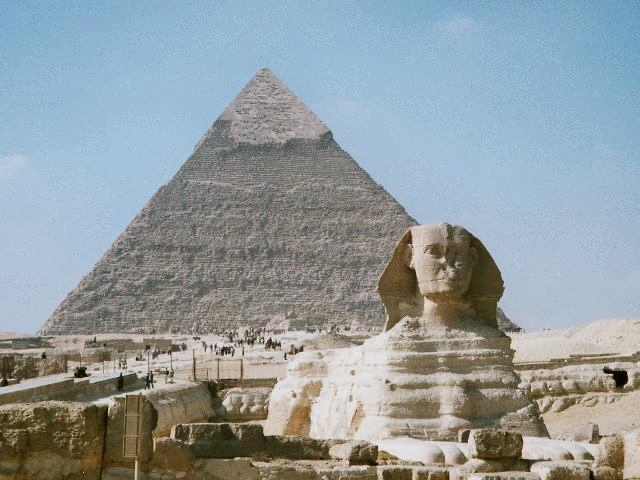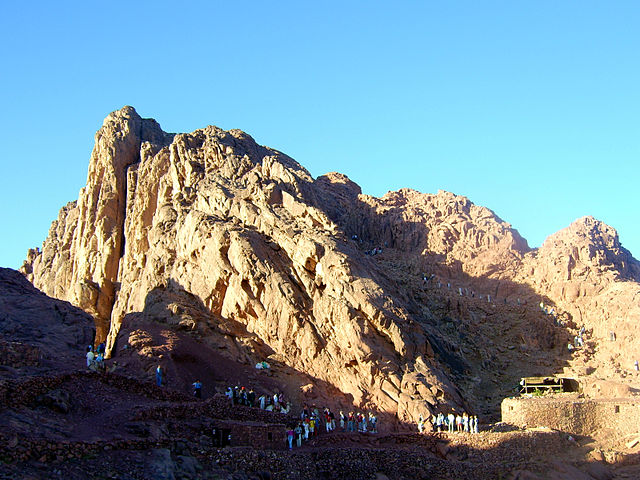Jubilee Pilgrimage, stage 1, Egypt, 24-26 February 2000
The journey in the footsteps of Moses, the patriarch of the Old Testament, was the first of the Jubilee Pilgrimage, during which the Pope visited places related to the history of salvation.
Mount Sinai. Photo: Wikipedia.
Drag timeline
February 24, 2000
CAIRO: Welcoming ceremony at the airport. The ceremony was attended by, among others. President Hosti Mubarak, Coptic Patriarch of Alexandria Stephen II Ghattas, Chaldean Bishop of Cairo Youssef Ibrahim Sarraf, Catholic bishops and Grand Sheikh Mohammed Sayed Tantawi - Private meeting with the President - Visit to Pope Shenuda III, head of the Coptic Orthodox Church - Meeting with Grand Sheikh Mohammed Sayed Tantawi, supreme leader of the followers of Islam in Egypt
February 25, 2000
CAIRO: Mass at the Palace of Sports - Ecumenical meeting at the Cathedral of Our Lady Patroness of Egypt
February 26, 2000
Mount Sinai: Pilgrimage to St Catherine's Monastery - Liturgy of the Word in the olive grove by the monastery (attended by about 100 people) CAIRO: Farewell and departure for Rome
Purpose
On the 2000th anniversary of the birth of Christ John Paul II planned a two-stage Jubilee Pilgrimage. The first stage was Egypt and the biblical Mount Sinai, where Moses received the Decalogue.
The purpose was also dialogue with other religions, especially with representatives of ancient Christian Churches.
The purpose was also dialogue with other religions, especially with representatives of ancient Christian Churches.
Context
The tradition says that the origins of the Church in
Egypt date back to the first century AD, and are related to the
activities of St. Mark the Evangelist, who was to establish a bishopric
in Alexandria. The country was in ancient times an important center of
theological thought, as well as monastic life developed there. The
division of Christianity in Egypt occurred in the fifth century, when
the Council of Chalcedon condemned Monophysitism (the doctrine of the
nature of Christ). Some of the faithful then separated from the
universal Church, giving rise to the Coptic Church (Coptic Orthodox
Church). Those who remained in the Catholic Church, called Melchites,
followed into schism with Rome in the 13th century; moving on to the
Orthodox Churches.
There is also a Coptic Catholic community in Egypt (in communion with Rome) and other Catholic communities - Latin, Greco-Melchite, Maronite, Syriac, Chaldean and Armenian. Overall, all Christians are in the minority, as Muslims constitute more than 90 percent of the 100-million-strong population.
There is also a Coptic Catholic community in Egypt (in communion with Rome) and other Catholic communities - Latin, Greco-Melchite, Maronite, Syriac, Chaldean and Armenian. Overall, all Christians are in the minority, as Muslims constitute more than 90 percent of the 100-million-strong population.
Course of the Pilgrimage
On
the first day of his visit, the Pope landed in the afternoon, still in
time to meet with the head of the Coptic Orthodox Church, Pope Shenuda
III, and Grand Sheikh Mohammed Sayed Tantawi, the highest representative
of Egypt's Muslim hierarchy.
The next day, he celebrated the Eucharist according to the Roman Rite (link to radio broadcast) at Cairo's Palace of Sports, which was attended by about 20,000 faithful. The Mass was celebrated in French, the liturgical chants were performed in Coptic, Armenian and Arabic, and the priests were dressed in liturgical vestments of different traditions.
The ecumenical meeting in the Cathedral of Our Lady Patroness of Egypt, which is the main church of the Coptic Catholic Patriarchate of Alexandria, was a highlight, bringing together representatives of the ancient Christian Churches, the Anglican and Lutheran communities, as well as Muslim clergy.
The culmination of the pilgrimage was a visit to Mount Sinai, where, according to the Holy Scriptures, Moses received from God the Ten Commandments on tablets of stone. The area around Mount Sinai is the cradle of Christian monasticism. In the sixth century Emperor Justinian built there a monastery surrounded by a wall, where the relics of St. Catherine of Alexandria are kept, as well as priceless mementos of Christian culture. The monastery is maintained by an autonomous community of Greek Orthodox monks.
Upon entering the Chapel of the Burning Bush, the Pope took off his shoes, kissed the ground and immersed himself in prayer (according to the Bible, God revealed himself to Moses in the burning bush). He also honored the relics of St. Catherine and viewed some precious icons, biblical manuscripts and liturgical furnishings. In an olive grove inside the monastery, he presided over a liturgy of the word (link to radio broadcast).

The next day, he celebrated the Eucharist according to the Roman Rite (link to radio broadcast) at Cairo's Palace of Sports, which was attended by about 20,000 faithful. The Mass was celebrated in French, the liturgical chants were performed in Coptic, Armenian and Arabic, and the priests were dressed in liturgical vestments of different traditions.
The ecumenical meeting in the Cathedral of Our Lady Patroness of Egypt, which is the main church of the Coptic Catholic Patriarchate of Alexandria, was a highlight, bringing together representatives of the ancient Christian Churches, the Anglican and Lutheran communities, as well as Muslim clergy.
The culmination of the pilgrimage was a visit to Mount Sinai, where, according to the Holy Scriptures, Moses received from God the Ten Commandments on tablets of stone. The area around Mount Sinai is the cradle of Christian monasticism. In the sixth century Emperor Justinian built there a monastery surrounded by a wall, where the relics of St. Catherine of Alexandria are kept, as well as priceless mementos of Christian culture. The monastery is maintained by an autonomous community of Greek Orthodox monks.
Upon entering the Chapel of the Burning Bush, the Pope took off his shoes, kissed the ground and immersed himself in prayer (according to the Bible, God revealed himself to Moses in the burning bush). He also honored the relics of St. Catherine and viewed some precious icons, biblical manuscripts and liturgical furnishings. In an olive grove inside the monastery, he presided over a liturgy of the word (link to radio broadcast).
On his
return to Rome, during a general audience on March 1, 2000, the Pope
commented on the event as follows: „With great joy I was able to go on
pilgrimage to Egypt last week in the footsteps of Moses. The high point
of this extraordinary experience occurred at the foot of Mount Sinai,
the Holy Mountain: holy because it was here that God revealed himself
to his servant, Moses, and told him his Name; holy, too, because it was
here that God gave his people the gift of his Law, the Ten Commandments;
holy, lastly, because by their constant presence believers have made
Mount Sinai a place of prayer.”
Saint Catherine's Monastery. Photo: Wikipedia

Effects
John Paul II began his
two-stage pilgrimage in the footsteps of salvation history by visiting
the place where God gave the people of Israel the Decalogue - the Ten
Commandments. The pilgrimage had an ecumenical dimension and brought
some progress to the dialogue with Muslims. Speaking of the visit to St.
Catherine's Monastery at the foot of Sinai, the pope made it clear that
"[it] will be a moment of intense prayer for peace and for
interreligious harmony." He continued, "To do harm, to promote violence
and conflict in the name of religion is a terrible contradiction and a
great offence against God. (...) We must all work to strengthen the
growing commitment to interreligious dialogue, a great sign of hope for
the peoples of the world. "As-salamu alaikum" - Peace be with you!".
Trivia
The
Mass celebrated in the Palace of Sports in Cairo with the participation
of about 20,000 faithful was the first Eucharistic liturgy in Egypt
celebrated in a public place, outside the walls of the church.
The Pope's Words
„In revealing himself on the Mountain and giving his Law, God revealed man to man himself. Sinai stands at the very heart of the truth about man and his destiny.
In pursuit of this truth, the monks of this Monastery pitched their tent in the shadow of Sinai. The Monastery of the Transfiguration and Saint Catherine bears all the marks of time and human turmoil, but it stands indomitable as a witness to divine wisdom and love. For centuries monks from all Christian traditions lived and prayed together in this Monastery, listening to the Word, in whom dwells the fullness of the Father’s wisdom and love. In this very Monastery, Saint John Climacus, wrote The Ladder of Divine Ascent, a spiritual masterpiece that continues to inspire monks and nuns, from East and West, generation after generation. All this has taken place under the mighty protection of the Great Mother of God. As early as the third century Egyptian Christians appealed to her with words of trust: We have recourse to your protection, O Holy Mother of God! Sub tuum praesidium confugimus, sancta Dei Genetrix! Through the centuries, this Monastery has been an exceptional meeting place for people belonging to different Churches, traditions and cultures. I pray that in the new millennium the Monastery of Saint Catherine will be a radiant beacon calling the Churches to know one another better and to rediscover the importance in the eyes of God of the things that unite us in Christ”.
Homily of John Paul II, St. Catherine’s Monastery, 26 February 2000
Author: BS
Sources
Audio Records
Documents
Audio Records
Event Place
Choose location...
Cairo
Mount Sinai
Keywords
General:
Persons index:
Geographical index:
Date:

